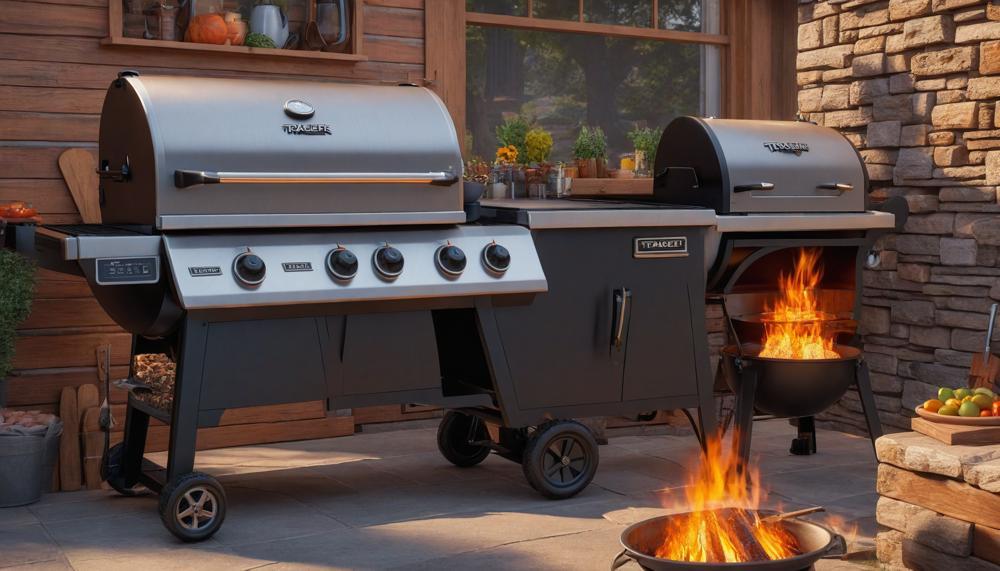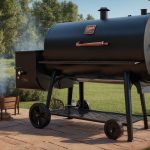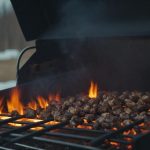Did you know that your Traeger grill can sometimes heat up beyond the temperature you set? This might come as a surprise, especially since precise temperature control is a hallmark of Traeger’s appeal to both novice and expert grillers alike. Why does this happen? The answer isn’t just about fluctuations; it’s about understanding the mechanics behind your grill’s operation and how external factors can influence it.
In this blog post, we’ll unravel the mystery behind why your Traeger grill might exceed its temperature settings, offering insights and solutions to help you maintain the perfect grilling environment. Here’s what you’ll discover:
- Key Reasons: We’ll outline the main reasons why temperature discrepancies occur in Traeger grills.
- Impact on Cooking: Understand how these fluctuations can affect your cooking results.
- Practical Solutions: Learn simple adjustments and best practices to keep your grill at the desired temperature.
Whether you’re smoking a brisket or firing up some veggies, knowing how to manage your Traeger’s temperature can make all the difference. Let’s dive into the details and get your grilling experiences back on track.
Contents
- 1 What Issues Occur at a High Internal Temperature
- 2 Is Your Traeger Temp Too High? – The Common Causes
- 3 AC Traeger Grill
- 4 App Out Of Date
- 5 Dirty Or Faulty RTD Probe
- 6 How An Error Code Can Indicate A Heat Issue
- 7 Maintaining Your Traeger To Avoid Temp Spikes and Fires
- 8 Other Common High-Temperature Issues and Fixes
- 9 The Optimum Temperature Range
- 10 Conclusion
What Issues Occur at a High Internal Temperature
| Risk | Consequence | Explanation |
| Overcooked or Burnt Food | Reduced Quality of Meal | High temperatures cause wood pellets to burn faster, increasing the heat, which can quickly lead to food that is overly dry or charred. |
| Flare-Ups | Potential Safety Hazard | Excess heat can cause grease or fat from cooking food to ignite suddenly, posing risks to both the meal and the user’s safety. |
| Grill Damage | Increased Maintenance Costs | Components such as the fire pot and hot rod may degrade quicker under high temperatures, potentially leading to malfunction or the need for replacements. |
| Health Risks | Possible Cancer Risk | Cooking at high temperatures can lead to the formation of harmful chemicals like HCAs and PAHs, which have been linked to cancer. |
| Fire Hazard | Risk to Environment and Safety | High internal temperatures, especially in dry or windy conditions, can escalate to dangerous fire situations outdoors. |
Maintaining an optimal temperature within your Traeger grill is crucial to avoid these risks.
Is Your Traeger Temp Too High? – The Common Causes
| Cause | Explanation | Solutions |
| Faulty temperature probes or sensors | Sensors may degrade over time or become coated in grease and debris, causing inaccurate readings. | Clean sensors regularly and replace if faulty. |
| Inaccurate startup process | Improper ignition or calibration during startup can lead to temperature spikes. | Follow the manufacturer’s guidelines for startup and shutdown procedures. |
| WiFIRE connectivity issues | Disruptions in Wi-Fi connectivity can affect the grill’s ability to regulate temperature effectively. | Ensure stable Wi-Fi connection; consider a Wi-Fi range extender if necessary. |
| Damage or debris build-up | Accumulation of pellets or ash can disrupt airflow and heat distribution, causing temperature inconsistencies. | Clean the grill thoroughly after each use; check for and repair any damage. |
| High ambient temperatures | Outdoor grilling in hot weather can lead to higher than expected internal temperatures. | Adjust the P-setting to account for changes in ambient temperature; open the grill lid briefly to let excess heat escape if needed. |
To ensure your Traeger grill maintains the correct temperature, it’s crucial to tackle these common issues proactively.

AC Traeger Grill
Answer: The AC (auger control) feature on a Traeger grill plays a pivotal role in managing the grill’s internal temperature by regulating the flow of pellets into the firepot, where they are ignited to produce heat. By adjusting the auger’s speed, the AC feature precisely controls the amount of heat generated, ensuring that the grill maintains the temperature set by the user.
However, several factors can cause the grill to exceed the temperature setting:
- Auger Control Malfunction: A malfunction in the auger control can lead to an excessive supply of pellets, which combust and drive the temperature above the desired setting. This could be due to issues like a faulty motor or a compromised control board that inaccurately regulates the auger’s speed.
- External Environmental Conditions: Weather plays a significant role; for instance, in very hot conditions, the grill can absorb additional ambient heat, pushing internal temperatures higher. Conversely, strong winds might increase the oxygen supply to the fire, intensifying the flames and thereby the temperature.
- Operational Errors: User mistakes, such as overloading the pellet hopper or frequently opening the grill lid, can also disrupt temperature regulation. Each lid opening can cause significant heat loss, prompting the AC to compensate by feeding more pellets than necessary into the firepot.
Understanding and mitigating these factors are crucial for maintaining the desired grilling temperature. Regular maintenance of the AC system and mindful grilling practices help mitigate overheating issues. Below is a table summarizing the key reasons for temperature discrepancies and their solutions:
| Cause | Effect | Solution |
| Auger Control Malfunction | Excess pellets lead to higher heat. | Check and repair motor or control board. |
| External Environmental Conditions | Weather conditions alter internal temperature. | Adjust grill setup relative to current weather. |
| Operational Errors | Improper usage affects temperature stability. | Adhere to operational guidelines and moderate lid opening. |
App Out Of Date
An outdated app linked to your Traeger grill can indeed lead to overheating issues beyond the temperature you’ve set. Here’s a breakdown of how this occurs:
- Compatibility Issues: An outdated app may not communicate effectively with your grill’s newer firmware versions. This mismatch can result in incorrect temperature readings and settings being relayed to the grill, causing it to operate hotter than intended.
- Software Bugs: Older versions of apps often contain unresolved bugs that can interfere with how temperature controls are managed within the app. These bugs might cause erratic temperature controls, leading to higher heat output.
- Delayed Updates: Updates in the app often include fixes for temperature regulation accuracy. Not having the latest version means missing out on these crucial updates, which help maintain precise control over the grill’s operation.
- User Interface Errors: An outdated interface might display incorrect temperature settings or not reflect changes made by the user correctly. This can lead users to inadvertently set a higher temperature than they intend.
Understanding these factors helps in maintaining the ideal operation of your Traeger grill. Here’s a table summarizing potential issues caused by an outdated app and their impacts on the grill:
| Issue | Consequence | Recommendation |
| Compatibility Issues | Miscommunication between app and grill | Update app regularly |
| Software Bugs | Erratic temperature control | Install latest app version |
| Delayed Updates | Lack of crucial fixes | Check for updates frequently |
| User Interface Errors | Incorrect temperature setting | Verify settings visually on both app and grill |
To mitigate these risks, always ensure your app is updated to the latest version.
Dirty Or Faulty RTD Probe
A dirty or faulty RTD (Resistance Temperature Detector) probe can cause your Traeger grill to heat up beyond the temperature you’ve set due to several key reasons, primarily centering on inaccurate temperature readings and signal disruptions. Here’s a detailed look at how these issues arise and the direct consequences:
- Inaccurate Temperature Readings: The RTD probe is designed to measure the grill’s internal temperature accurately. If the probe is dirty, covered in grease or debris, its ability to sense temperature is significantly hindered. This results in it transmitting incorrect temperature data to the grill’s controller. Consequently, if the probe erroneously registers a lower temperature than the actual grill temperature, the controller will continue to supply more heat, mistakenly trying to reach the desired temperature setpoint, thereby overshooting it.
- Signal Disruption: Dirt or damage can cause interruptions in the electrical signals sent from the probe to the controller. These disruptions can lead to erratic temperature regulation where the grill’s temperature might spike or dip unpredictably, often resulting in the grill running hotter.
Here’s a summary in a table format illustrating the impact of a dirty or faulty probe on your Traeger grill:
| Problem | Consequence | Result |
| Accumulated Grease/Debris | Inaccurate lower temperature readings | Controller overcompensates with higher heat |
| Disrupted Electrical Signals | Erratic temperature fluctuations | Unstable and often higher grill temperatures |
| Faulty Probe Components | Miscommunication to controller | Consistent overheating beyond set temp |
For grill aficionados aiming for that perfect barbecue, maintaining a clean and fully functional RTD probe is essential. Not only does this help in achieving precise cooking temperatures, but it also ensures that your food is cooked just the way you like it—neither undercooked due to low heat nor charred from excessive temperatures.
How An Error Code Can Indicate A Heat Issue
Error codes on a Traeger grill are crucial diagnostics that point out specific troubles, including those linked to heating. These codes pop up on the grill’s control panel, offering a swift hint that something’s amiss. For instance, should you encounter the ‘ERR’ error code, it generally indicates an issue with the temperature sensor, which could lead to improper grill heating.
This could mean the grill either overheats or fails to reach the desired temperature, potentially spoiling your BBQ efforts.
Here’s a brief overview of how specific error codes relate to heat issues:
| Error Code | Meaning | Common Cause |
| ERR | Temperature Sensor Malfunction | May cause erratic temperature control, leading to under or overheating. |
| LERR | Lighting Error | Indicates problems igniting the grill, affecting the ability to reach cooking temperature. |
| HERR | Hopper Error | Relates to issues with the auger, which can prevent pellets from feeding into the firepot, thus affecting the grill’s heat. |
To effectively address a heat issue revealed by an error code:
- Consult the manual: Each error code has troubleshooting steps listed in the grill’s manual.
- Check and clean: Ensure the grill components such as the temperature sensor, hot rod, and fire pot are clean and intact.
- Component inspection: Replace faulty parts like sensors or augers as needed, especially if they continue to trigger error codes after cleaning.
By paying attention to these codes and understanding their meanings, you maintain not only the grill’s longevity but also the quality of your barbecue, ensuring every dish is grilled to perfection.
Maintaining Your Traeger To Avoid Temp Spikes and Fires
Regular maintenance is key to preventing temperature spikes and potential fires in your Traeger grill. By adhering to a consistent upkeep routine, you safeguard your grill’s operation and enhance your BBQ experience. Here’s how each maintenance step helps:
| Maintenance Task | Purpose | Fire Risk Mitigation |
| Cleaning post-use | Remove grease/pellet residue | Eliminates ignition sources |
| Inspecting auger and motor | Ensure smooth pellet delivery | Prevents mechanical overheating |
| Calibrating RTD probe | Maintain accurate temperature control | Avoids temperature misreadings leading to spikes |
| Shading the grill | Reduce external temperature effects | Lessens risk of overheating |
| Emergency procedures | Quick response to issues | Immediate risk reduction |
Other Common High-Temperature Issues and Fixes
If you find your Traeger grill sizzling past the temperature you’ve dialed in, there are several potential culprits and handy solutions to consider. Here’s a rundown of common issues and fixes:
| Issue | Possible Cause | Solution |
| Temperature Fluctuations | Environmental Factors | Shield your grill from wind and direct sunlight, possibly moving it to a more sheltered location. |
| Overheating | Buildup of Pellets | Ensure the auger is not jammed with pellets. A clean path allows for even pellet distribution and stable temperatures. |
| Unreliable Temperature Readings | Faulty Temperature Probe | Check the probe for damage or dirt. Replace or clean it if necessary to ensure accurate readings. |
| Excessive Preheating | User Error | Adhere strictly to the recommended preheating time, avoiding prolonged heating which can cause temperature overshoot. |
| Software Issues | Outdated Grill Firmware | Update your Traeger’s firmware via the official app to ensure optimal performance and accurate temperature controls. |
This guide not only helps maintain your Traeger in top shape but also ensures your barbecues are both safe and delicious.
The Optimum Temperature Range
The ideal temperature range for using a Traeger grill varies depending on what you’re cooking but generally falls between 225 and 450 degrees Fahrenheit. This range allows for everything from slow-smoking to high-heat searing. However, it’s not uncommon for your Traeger to exceed these temperatures due to a few reasons.
Firstly, external factors such as ambient temperature, wind, and even the placement of the grill can influence the internal temperature. On a particularly windy day or when the grill is placed in direct sunlight, you might notice higher readings. Secondly, the buildup of ash from previous grilling sessions can insulate the firepot, causing the grill to get hotter than intended. Regular cleaning is crucial to manage this issue.
Furthermore, pellet quality plays a significant role. Low-quality pellets may burn inconsistently, leading to temperature spikes. Using high-quality, brand-recommended pellets can help maintain a stable temperature.
Here’s a breakdown of why a Traeger might be running hot and how to mitigate these factors:
| Cause | Impact | Mitigation |
| Ambient Conditions | Wind and sunlight can increase internal temperature. | Position the grill in a shaded, wind-sheltered area. |
| Ash Buildup | Insulates the firepot, increasing temperature. | Clean the grill regularly, especially the firepot area. |
| Pellet Quality | Poor-quality pellets burn hotter and less consistently. | Use high-quality, manufacturer-recommended pellets. |
Conclusion
Understanding why your Traeger grill might exceed the set temperature is key to mastering the art of grilling. Various factors, from faulty equipment to environmental influences, can disrupt your cooking experience by causing your grill to run hotter than intended.
The heart of the issue often lies in malfunctioning components such as temperature probes or sensors that become inaccurate due to dirt or damage. Moreover, external conditions like high ambient temperatures or direct sunlight can trick your grill into working overtime, intensifying the internal heat. Not to overlook, operational errors such as improper startup procedures or frequent lid opening can contribute to these temperature spikes.
Equipped with this knowledge, you can take proactive steps to ensure your grill operates within the ideal temperature range. Regular maintenance, including cleaning and inspecting key components like the RTD probe and auger system, plays a crucial role. Also, adapting grilling practices to accommodate for environmental changes ensures that you maintain control over the heat.






